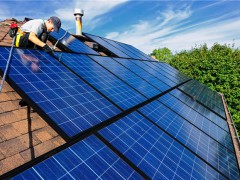據(jù)1月19日Rigzone報(bào)道,在努力恢復(fù)石油生產(chǎn)這個(gè)過程中,歐佩克及其盟友的剩余供應(yīng)量越來越少,這可能為原油價(jià)格帶來一個(gè)炎熱的夏天。
從尼日利亞到俄羅斯,投資低迷和內(nèi)部動蕩使聯(lián)盟成員國步履蹣跚,滿足世界燃料消費(fèi)強(qiáng)勁復(fù)蘇的任務(wù)落到了少數(shù)中東產(chǎn)油國身上。隨著產(chǎn)量提高,為應(yīng)對緊急中斷而保留的未開發(fā)供應(yīng)將變得越來越不穩(wěn)定。
摩根士丹利石油策略師Martijn Rats表示,“石油市場似乎正在進(jìn)入一個(gè)安全系數(shù)很小的時(shí)期,價(jià)格將需要上升到需求受到一定削弱的水平”。
7月份假日出行季節(jié)將推動全球燃料使用量超過每天1億桶,世界儲備能力將幾乎完全由沙特阿拉伯、阿拉伯聯(lián)合酋長國和伊拉克持有,并且可能只有230萬/天,這是自2018年以來最低水平。
雖然這種關(guān)系不是絕對的,但閑置產(chǎn)能低的時(shí)期往往與價(jià)格上漲相關(guān),反之亦然,因?yàn)榻灰咨桃磳ξC(jī)發(fā)生時(shí)的可用供應(yīng)增加了信心,要么感到焦慮。2008年原油飆升至每桶近150美元?dú)v史高點(diǎn),當(dāng)時(shí)石油儲備量變得非常低。
這使得歐佩克及其合作伙伴的艱難處境成為石油消費(fèi)國令人擔(dān)憂的前景。由于全球燃料需求經(jīng)受住了奧密克戎沖擊,國際原油價(jià)格已經(jīng)處于每桶85美元以上的七年高位。
這助長了通貨膨脹壓力,給數(shù)百萬人帶來生活成本危機(jī),危及全球經(jīng)濟(jì)復(fù)蘇。美國國家安全委員會(National Security Council)發(fā)言人埃米莉·霍恩(Emily Horne)在一份聲明中表示,白宮正在密切關(guān)注這一情況,并與包括歐佩克+成員國在內(nèi)的產(chǎn)油國合作,確保供應(yīng)增長以滿足需求。
如果國際能源署的預(yù)測被證明是正確的,即美國、巴西和加拿大將在今年晚些時(shí)候恢復(fù)創(chuàng)紀(jì)錄產(chǎn)油量,那么這種危機(jī)就會消退。
歐佩克+正在逐步恢復(fù)疫情期間停止的大量供應(yīng),每月逐步恢復(fù)40萬桶/天。但事實(shí)上,由于安哥拉和尼日利亞等國面臨支出減少和運(yùn)營中斷的問題,新增石油產(chǎn)量要少得多。
阿曼石油部長穆罕默德·魯米1月12日在利雅得接受采訪時(shí)表示,"這并不容易,因?yàn)榇嬖诋a(chǎn)能問題。過去五年,對該行業(yè)的投資有限,我們現(xiàn)在正為此付出代價(jià)”。
12月,協(xié)議中的10個(gè)歐佩克國家只完成了規(guī)定的25萬桶/天增產(chǎn)量的60%。這場危機(jī)延伸到了整個(gè)歐佩克+聯(lián)盟,甚至該集團(tuán)的第二大生產(chǎn)國俄羅斯也未能在12月增加產(chǎn)量,預(yù)計(jì)該國今后只能實(shí)現(xiàn)其配額產(chǎn)量的一半。
高盛集團(tuán)(Goldman Sachs Group Inc.)大宗商品研究主管杰夫·柯里(Jeff Currie)表示,"由于缺乏投資,俄羅斯現(xiàn)在甚至無法達(dá)到歐佩克+目標(biāo)。目前只有兩個(gè)國家的產(chǎn)量,可以超過2020年1月產(chǎn)量,即沙特阿拉伯和阿聯(lián)酋" 。
減產(chǎn)的不僅是歐佩克+,根據(jù)總部設(shè)在巴黎的國際能源署數(shù)據(jù)顯示,由于油價(jià)下滑,2020年對新供應(yīng)的投資暴跌了30%。美國頁巖油生產(chǎn)商繼續(xù)限制鉆井開支,同時(shí)在多年資金消耗后還向股東歸還資本。
隨著中東重量級生產(chǎn)商負(fù)擔(dān)加重,為在供應(yīng)中斷情況下提供緩沖而保留的閑置產(chǎn)能將被耗盡。這可能會使全球市場暴露在斷供危險(xiǎn)中,斷供仍然是一個(gè)無法消除的威脅。
根據(jù)彭博社計(jì)算,到7月份,當(dāng)美國駕車者上路度假,波斯灣出口商在家里燒更多燃料時(shí),歐佩克+持有的閑置生產(chǎn)能力可能已經(jīng)減少到每天只有230萬桶。根據(jù)國際能源署數(shù)據(jù),產(chǎn)能最后一次接近這種水平是在2018年第四季度。
如果歐佩克+繼續(xù)按照目前的速度供能,隨著該集團(tuán)恢復(fù)剩余的閑置供應(yīng),下半年緩沖供應(yīng)將變得更少。
美國銀行(Bank of America)大宗商品和衍生品研究全球主管弗朗西斯科?布蘭奇(Francisco Blanch) 表示,“隨著需求恢復(fù),2022年將是供應(yīng)緊張的一年”。
王佳晶 摘譯自 Rigzone
原文如下:
Oil Prices Potentially Set Up for Sizzling Summer
As they strain to restore oil production, OPEC and its allies are being left with a diminishing buffer of spare supplies -- potentially setting up crude prices for a sizzling summer.
With depressed investment and internal unrest hobbling coalition members from Nigeria to Russia, the task of satisfying the vigorous recovery in world fuel consumption is down to just a few Middle Eastern producers. As they raise production, the buffer of untapped supplies held back to cover any emergency disruptions will grow ever-more precarious.
“The oil market appears to be heading for a period with little margin of safety,” said Martijn Rats, oil strategist at Morgan Stanley. “Prices will need to rise to levels where some demand erosion takes place.”
By the time the holiday driving season propels global fuel use above 100 million barrels a day in July, the world’s reserve capacity will be almost entirely held in Saudi Arabia, the United Arab Emirates and Iraq, and could amount to just 2.3 million a day -- the lowest since 2018.
While the relationship isn’t absolute, periods of low spare capacity often correlate with rising prices -- and vice versa -- as traders either grow confident or anxious over how much supply would be available in the event of a crisis. Crude’s spike to an all-time high of almost $150 a barrel in 2008 came as reserves became perilously low.
This makes the travails of the Organization of Petroleum Exporting Countries and its partners a worrisome prospect for oil-consuming nations. International crude prices are already at a seven-year high above $85 a barrel as global fuel demand withstands the omicron variant of Covid-19.
That’s feeding into the inflationary pressure that imperils the global recovery by inflicting a cost-of-living crisis on millions of people. The White House is keeping a close eye on the situation, and is working with oil-producing countries including members of OPEC+ to ensure supply rises to meet demand, National Security Council spokeswoman Emily Horne said in a statement on Tuesday.
The danger could recede if IEA forecasts prove correct that the U.S., Brazil and Canada will return to pump at record levels later this year.
Missing Targets
Formally, OPEC+ is gradually restoring the vast swathe of production halted during the pandemic in gradual monthly installments of 400,000 barrels a day. But in practice, the volumes added have been significantly smaller as nations like Angola and Nigeria struggle with diminished spending and operational disruptions.
“It’s not easy because there’s a problem of capacity,” Oman’s Oil Minister Mohammed Rumhi said in an interview in Riyadh on Jan. 12. “The last five years the investments have been limited in the industry and we’re paying the price for it now.”
Last month the 10 OPEC nations in the accord managed only 60% of their stipulated 250,000 barrel-a-day increase. The crisis extends across the OPEC+ coalition, with even Russia -- the second-largest producer in the group -- failing to increase output in December. The country is expected to deliver only half its permitted hikes going forward.
“Russia can’t even hit their OPEC+ target right now because of a lack of investment,” Jeff Currie, head of commodities research at Goldman Sachs Group Inc., said in a Bloomberg television interview. “There are only two countries that can produce more today than they could in January 2020. Who are those? Saudi Arabia, the UAE.”
The downturn extends beyond OPEC+. Investment in new supplies tumbled by 30% in 2020 as oil prices slumped, according to the Paris-based International Energy Agency. U.S. shale producers continue to limit spending on drilling while they return capital to shareholders after years of burning through cash.
As the burden intensifies on the Middle East heavyweights, the spare capacity they hold back as a kind of shock absorber in case of a supply disruption becomes depleted. That could leave global markets dangerously exposed to outages, which remain a constant threat.
By July, when U.S. motorists take to the road for vacations and Persian Gulf exporters burn more fuel at home for air conditioning, spare production capacity held by OPEC+ may have diminished to just 2.3 million barrels a day, according to Bloomberg calculations. Capacity was last near such levels in the fourth quarter of 2018, according to the International Energy Agency.
If OPEC+ continues on its current trajectory, the cushion will become even smaller in the second half as the group revives the remainder of its offline supplies.
“It’s going to be a tight 2022 as demand recovers,” Francisco Blanch, global head of commodities and derivatives research at Bank of America, said in a Bloomberg TV interview.
免責(zé)聲明:本網(wǎng)轉(zhuǎn)載自其它媒體的文章,目的在于弘揚(yáng)石化精神,傳遞更多石化信息,并不代表本網(wǎng)贊同其觀點(diǎn)和對其真實(shí)性負(fù)責(zé),在此我們謹(jǐn)向原作者和原媒體致以敬意。如果您認(rèn)為本站文章侵犯了您的版權(quán),請與我們聯(lián)系,我們將第一時(shí)間刪除。







